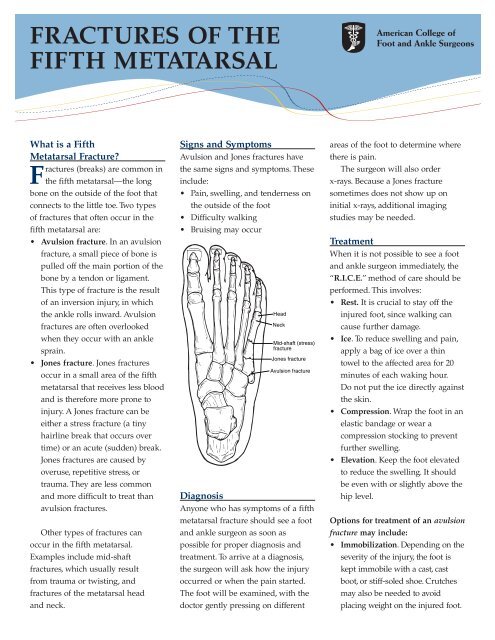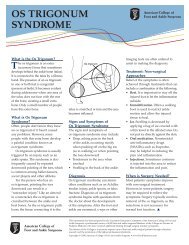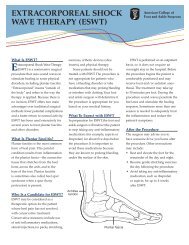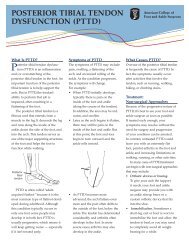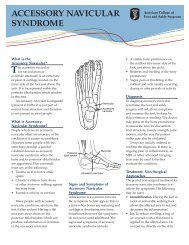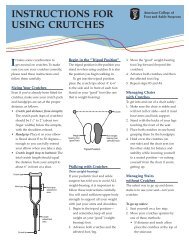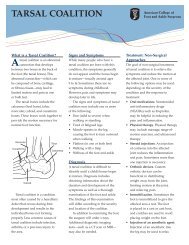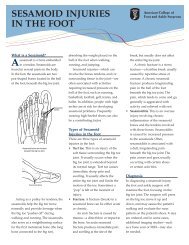FRACTURES OF THE FIFTH METATARSAL
FRACTURES OF THE FIFTH METATARSAL
FRACTURES OF THE FIFTH METATARSAL
You also want an ePaper? Increase the reach of your titles
YUMPU automatically turns print PDFs into web optimized ePapers that Google loves.
<strong>FRACTURES</strong> <strong>OF</strong> <strong>THE</strong><br />
<strong>FIFTH</strong> <strong>METATARSAL</strong><br />
What is a Fifth<br />
Metatarsal Fracture?<br />
Fractures (breaks) are common in<br />
the fifth metatarsal—the long<br />
bone on the outside of the foot that<br />
connects to the little toe. Two types<br />
of fractures that often occur in the<br />
fifth metatarsal are:<br />
• Avulsion fracture. In an avulsion<br />
fracture, a small piece of bone is<br />
pulled off the main portion of the<br />
bone by a tendon or ligament.<br />
This type of fracture is the result<br />
of an inversion injury, in which<br />
the ankle rolls inward. Avulsion<br />
fractures are often overlooked<br />
when they occur with an ankle<br />
sprain.<br />
• Jones fracture. Jones fractures<br />
occur in a small area of the fifth<br />
metatarsal that receives less blood<br />
and is therefore more prone to<br />
injury. A Jones fracture can be<br />
either a stress fracture (a tiny<br />
hairline break that occurs over<br />
time) or an acute (sudden) break.<br />
Jones fractures are caused by<br />
overuse, repetitive stress, or<br />
trauma. They are less common<br />
and more difficult to treat than<br />
avulsion fractures.<br />
Other types of fractures can<br />
occur in the fifth metatarsal.<br />
Examples include mid-shaft<br />
fractures, which usually result<br />
from trauma or twisting, and<br />
fractures of the metatarsal head<br />
and neck.<br />
Signs and Symptoms<br />
Avulsion and Jones fractures have<br />
the same signs and symptoms. These<br />
include:<br />
• Pain, swelling, and tenderness on<br />
the outside of the foot<br />
• Difficulty walking<br />
• Bruising may occur<br />
Head<br />
Neck<br />
Mid-shaft (stress)<br />
fracture<br />
Jones fracture<br />
Avulsion fracture<br />
Diagnosis<br />
Anyone who has symptoms of a fifth<br />
metatarsal fracture should see a foot<br />
and ankle surgeon as soon as<br />
possible for proper diagnosis and<br />
treatment. To arrive at a diagnosis,<br />
the surgeon will ask how the injury<br />
occurred or when the pain started.<br />
The foot will be examined, with the<br />
doctor gently pressing on different<br />
areas of the foot to determine where<br />
there is pain.<br />
The surgeon will also order<br />
x-rays. Because a Jones fracture<br />
sometimes does not show up on<br />
initial x-rays, additional imaging<br />
studies may be needed.<br />
Treatment<br />
When it is not possible to see a foot<br />
and ankle surgeon immediately, the<br />
“R.I.C.E.” method of care should be<br />
performed. This involves:<br />
• Rest. It is crucial to stay off the<br />
injured foot, since walking can<br />
cause further damage.<br />
• Ice. To reduce swelling and pain,<br />
apply a bag of ice over a thin<br />
towel to the affected area for 20<br />
minutes of each waking hour.<br />
Do not put the ice directly against<br />
the skin.<br />
• Compression. Wrap the foot in an<br />
elastic bandage or wear a<br />
compression stocking to prevent<br />
further swelling.<br />
• Elevation. Keep the foot elevated<br />
to reduce the swelling. It should<br />
be even with or slightly above the<br />
hip level.<br />
Options for treatment of an avulsion<br />
fracture may include:<br />
• Immobilization. Depending on the<br />
severity of the injury, the foot is<br />
kept immobile with a cast, cast<br />
boot, or stiff-soled shoe. Crutches<br />
may also be needed to avoid<br />
placing weight on the injured foot.
• Surgery. If the injury involves a<br />
displaced bone, multiple breaks,<br />
or has failed to adequately heal,<br />
surgery may be needed.<br />
Options for treatment of a Jones<br />
fracture may include:<br />
• Immobilization. As with avulsion<br />
fractures, initial treatment may<br />
involve immobilization, but<br />
typically for a longer period of<br />
time because these fractures take<br />
longer to heal.<br />
• Bone stimulation. A pain-free<br />
external device is used to speed<br />
the healing of some fractures.<br />
Bone stimulation may be used as<br />
part of the treatment or following<br />
an inadequate response to<br />
immobilization.<br />
• Surgery. Surgery may be needed,<br />
since Jones fractures often do not<br />
heal through immobilization and<br />
bone stimulation.<br />
If surgery is required for treatment<br />
of a fifth metatarsal fracture, the foot<br />
and ankle surgeon will determine the<br />
type of procedure that is best suited<br />
to the individual patient. ▲<br />
This information has been prepared by the Consumer Education Committee of the American College of Foot and<br />
Ankle Surgeons, a professional society of 6,200 foot and ankle surgeons. Members of the College are Doctors of<br />
Podiatric Medicine who have received additional training through surgical residency programs.<br />
The mission of the College is to promote superior care of foot and ankle surgical patients through education,<br />
research and the promotion of the highest professional standards.<br />
Copyright © 2007, American College of Foot and Ankle Surgeons • www.FootPhysicians.com


